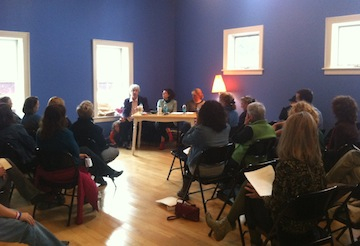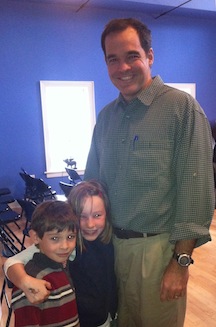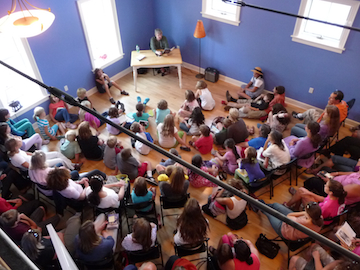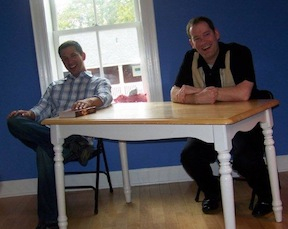Here’s a quick round-up of the what’s happened thus far at the annual New England Independent Booksellers Association trade show in Providence.
First off, I spent half an hour driving around downtown Providence trying in vain to find my hotel. Apparently, the Westin is not actually on my GPS. But a very kindly man told me to make three lefts and I would find it. And I did. Unfortunately, by the time I got checked in, dropped my bags off, I had missed the first 20 minutes of the plenary session: The Bookstore of the Future.
Perhaps it’s because I’m tired, but I didn’t find much that was encouraging about this panel. Gayle Shanks said it best,”We are all killing ourselves. What’s the next thing we need to do to stay alive. If you lose a bookstore, you lose culture.” It’s so true. One thing that folks said was helpful was buying an Espresso book publishing machine so inventory would never be a problem; we could just print what we were out of and we could compete with Amazon that way. Unfortunately, those machines are upwards of $100,000. I doubt there are many stores that can afford to buy that. One of the panelists suggested that 10 bookstores share a machine. A great idea in cities perhaps, but thoroughly unrealistic for rural stores.
The children’s dinner, was of course, a lovely highlight. How nice it is to see old friends again. I often forget how much it means to me to see and commiserate with my New England bookselling friends. The speakers were wonderful: Loren Long, Ally Condie, and Brian Selznick. All three spoke about writing. Loren talked about drawing Snoopy on the kitchen floor, being encouraged by his non-artist parents who even held an art show for him in the house. When he was talking about his new picture book, Otis and the Tornado, he told a story about growing up in Missouri and there was a tornado when he was a kid. He worried that the book might scare kids who had lived through a tornado, but his editor said it would okay. Then when the book was in final production a tornado struck where Loren grew up: Joplin, Missouri was all but flattened by a massive tornado. A chill washed over the room when he said that. And he said he knew doing the book was the right thing to do.
Ally Condie was incredibly down to earth. She maintains her teaching license because she wants to be able to maybe one day go back to teaching high school English. Growing up and living in southern Utah has informed her writing in lots of ways. The setting for Crossed is a canyon near her house; the canyons provides a harshness and a lushness in one area that allows for a lot of plot points. Her brother, a marine biologist, helped her learn about fish and how to survive in the wild. She was talking about how each of the other speakers has touched her life and that of her three young sons. “I’m probably going to cry because I have three little kids and I’m so very tired, but books do for my kids what I can’t.” It turns out that her younger sons loved Loren’s version of The Little Engine That Could, and The Invention of Hugo Cabret was the summer read-aloud for her eight-year-old son.
Brian Selznick started his career as a children’s bookseller in New York City, actually, which will endear him to me forever. His process for Hugo was having the theme first, then adding the structure. Wonderstruck, his new bestseller, started exactly oppositely – with the structure and then the theme. The book deals with deafness, and I was struck by the depth of his research into the subject. Brian said he was wary of writing about a minority that he was not a member of. It took him three years to write the book. He shared some marked-up pages from his editor, whose comments sometimes extended to the back of the page. The blue pencil marks were extensive and I think we all saw how much work the writing was for him. The drawings were done and were great, and then he had to work on the writing; as he said, “Turns out the writing is really hard.” I think we forget that the writing is hard, even for people who make it seem easy.
Look for another show recap on Monday.
Some Thoughts for Parents
Josie Leavitt - October 11, 2011
After the long holiday weekend and the busyness we had, I had a few pointers I wanted to share with parents shopping with their families.
– Do not shop if anyone in your party is hungry. Nothing ruins a fun time browsing at the bookstore more than a hungry toddler or spouse who really has no patience for anything other than protein.
– Do encourage your child to pursue whatever book he or she feels like reading. There’s a reason older kids might want to revisit picture books, or a child might want to stretch and read a seemingly more difficult book. Obviously, one needs to be aware of content. See the next point.
– Just because they want to read it doesn’t mean they should. No one knows your child better than you. If your toddler, who might be afraid of the dark, is picking an older-kid, really scary Halloween book, maybe it’s okay to redirect them to a gentler book.
– Remember that little kids don’t always understand “We’re here to get so-and-so a gift.” To me, doing that with toddlers is akin to making me sit a pizza place, while I carefully help someone else choose a pie that they’re not sharing. It would be very, very hard and I might get cranky. I know it’s unrealistic to think a child should get a book or toy every time they come to the store, but don’t get mad at a little one for not quite grasping “the present for someone else” concept.
– Be kind to all the readers in your family. Not every kid is a great reader. And if there’s a disparity between reading levels/skills with your kids, you don’t need to point it out. They know, and I don’t need to. Nothing kills me more than a parent saying, “She’s not my reader.”
– Have fun at the bookstore. Be silly when you read a picture book on the floor. I know it seems like we all can hear you, but actually we’re working, so don’t be shy about reading. Nothing makes us happier than a family laughing together.
– If you can’t get your child a book on a particular visit, ask if the store has a wish list. We keep a binder in the back and it’s full of kids’ names and their desired books. The mere act of writing down a title and storing it often goes a long way toward staving off a tantrum and letting the child feel heard.
– Stick to your guns. If you’ve set a limit and the kids are pushing you to get more, tell them no. I always respect the parents who make the hard choice of a possible tantrum rather than caving in to the child’s demands. We once had a mom carry her screaming son out of the store over her shoulder because he wasn’t listening. They came in the next day and tried again with great success. I practically applauded. And now, whenever they come in, everyone behaves well.
– Keep doing what you’ve been doing: surrounding your child with books. They’ll be lifelong readers who appreciate books.
– Remember that books create memories; being part of a child’s life is a gift, and combining books with children is a wonderful thing.
– Lastly, thanks to all of you who continue to bring your kids to the bookstore. They delight us every day and we love to be part of your family with books.
How Stickers Can Save the Day
Josie Leavitt - October 10, 2011
Why is it that if an order from either a publisher or a distributor is going to be messed up, it’s always on a Friday? This past Friday found us scrambling for books that should have come in.
A lovely customer who was on the fence about whether or not to get 14 paperbacks of I Stink to give as party favors for her son’s birthday on Saturday made the decision on Wednesday afternoon. This meant we only had Thursday to place our order. We called a distributor and were told they had all the copies we needed. So we placed the order and didn’t think any more of it. In a perfect world, and one we usually live in, except when there’s a deadline for a book, we would have gotten 14 books on Friday.
The boxes came Friday and were unboxed quickly, only to reveal seven I Stink books. Of course it was Friday which meant we had no time to order more from anyone else. So we scrambled. I called all the other indies in town, sadly only two phone calls were made. No one had the book. I spent much of my morning saying, “I Stink” over and over again, it started to just get funny.
We managed to find three copies of the book on the shelves, so we had 10 all together. We called her and explained the situation. There’s really nothing worse than knowing you’re disappointing a kid. Of course, none of it was our fault, but the mom didn’t see it that way at first. She was mad. I understood that, but there was nothing I could do, so yelling at me wasn’t really going to do any good. And I couldn’t really say perhaps a cushion of a week or so for that many books would have been nice. She wound up speaking to everyone on staff and we all apologized. We all felt bad – horrible in fact.
We wanted to make the party a success, so we added enough stickers sheets for every child to get at least three sheets and some temporary tattoos. The mom came in to pick up the books and was touched by the stacks of sticker sheets. We apologized again and she vowed next year to order party favors with more of a time cushion.
All was not lost. We kept a good customer happy. We didn’t disappoint a child and that was a great feeling.
Heart and Soul
Josie Leavitt - October 6, 2011
It’s that time of year again. The time of year when the store is full to bursting with all the great bo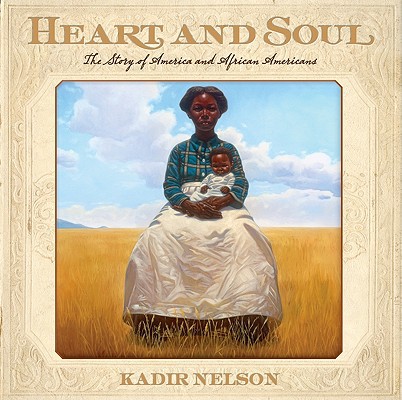 oks of the fall. Every day the UPS and FedEx drivers unload box after box that we eagerly unpack and try to shelve on our already over-full shelves.
oks of the fall. Every day the UPS and FedEx drivers unload box after box that we eagerly unpack and try to shelve on our already over-full shelves.
Some of my favorite picture books arrived in recent weeks. Perhaps my favorite of all is Heart and Soul by Kadir Nelson. It’s one of the most visually artful books I’ve seen a long while. This book’s lofty aim is to capture the history of African Americans in America, and it succeeds beautifully. This book works on many levels.
The paintings are so beautiful and heartbreaking and inspiring that it’s easy to just following the history through the paintings alone. This allows the book to work with younger children who can have a parent talk about the paintings rather than reading the text. I got lost in the faces that populate the book. From the cover image of a woman holding a baby in field to a burning, fiery cross, to the very last painting of an elderly woman’s open hand holding a button “I voted” about casting a vote for Barack Obama. The art resonates with the reader a long time after they’ve put the book down.
Having the narrator be a grandmother-type who has a sense of humor, is honest and tells a good tale is a wonderful way to approach history. The narrator fills in the gaps the paintings cannot. When the narrator refers to the reader as “honey” or “chile” it doesn’t sound cloying. It sounds like I’m on the porch with her spending a long afternoon hearing her stories and learning the real history of African Americans. What I especially like is the assumption that the reader is family. There was an accessibility to this device that hooked me right away. I felt like the history, my family history, was being told to me, almost as a rite of passage. I think most families have that moment when they sit the children of a certain age down and tell them the family stories. This book is that story.
I have spent hours, literally, looking at this book. I cannot get enough of it. It’s so real and brings the history of African Americans to life in a way no other book has for me. The combination of evocative art and a narrator you want to spend the day with makes this book a glorious success.
And if this doesn’t win a medal, or two, in January, I’ll be stunned.
Pitchapalooza – Great for Your Town!
Elizabeth Bluemle - October 5, 2011
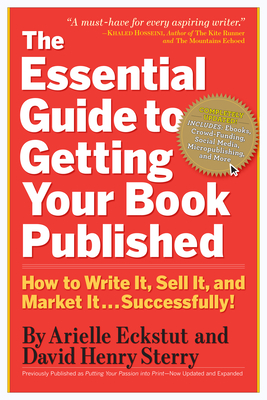 Everyone wants to write a book, right? We had an event on Sunday that I think any town would love: a chance for aspiring authors to pitch their book ideas to a panel of experts and receive feedback — along with a chance to win an introduction to an agent or publishing house.
Everyone wants to write a book, right? We had an event on Sunday that I think any town would love: a chance for aspiring authors to pitch their book ideas to a panel of experts and receive feedback — along with a chance to win an introduction to an agent or publishing house.
“Book Doctors” Arielle Eckstut and David Henry Sterry, authors of The Essential Guide to Getting Your Book Published: How to Write It, Sell It, and Market It . . . Successfully, and Workman Publishing sales representative Katie McGarry, served as the panel of pros to whom our roomful of hopefuls pitched their wares. The way it worked was this: participants RSVP’d for the event, knowing that there would be time for about 20-25 of them to get one precious minute in which to give an “elevator pitch” for their book; in effect, a literary audition.
After a lively, encouraging introduction, in which David and Arielle gave their own book’s one-minute pitch (“walking the walk,” as Sterry put it) in unison, they each spoke a bit about their backgrounds: David, about being a bestselling author, Arielle about her life as a literary agent, Katie, sharing her background as a seasoned publishers’ sales rep.
Then the team worked from the RSVP list and called up participants one at a time. After each sixty-second pitch (timed exactly and fairly, which took an element of anxiety out of those waiting their turn), the three gave excellent feedback about the structure and content of the pitch itself, and about the book idea and its possible positioning in the marketplace.
What astonished us was how GOOD all the pitches were! I’m not just saying that, either. Either this event draws only the really committed writers dedicated to their craft, or Vermont is just jam-packed with talent. Probably both. Many of the writers were known to us as customers; several surprised us with their literary aspirations. A few were published authors already, there to test out ideas in new genres. And some folks were new to the store altogether. All of them were a true pleasure to listen to, and that is no small feat when your own profession is basically encountering book pitches in some form or other all day long. Every memoir pitched had an interesting hook and subject matter; the novels were fresh and intriguing. It was a fascinating afternoon.
The “panel of pros” were equally terrific. Their comments were helpful, positive, focused, and honest, and each had a unique perspective to share. It’s not always easy to tell people what isn’t working about an idea or a proposal, but these three folks are so experienced in the field that they can articulate the challenges clearly while also pointing writers in the right direction to make the pitch (and possibly the book) better, more effective, more appealing to the first round of gatekeepers in a book’s life. Thoughtful and kind, they proved themselves the best kind of shepherds.
They also were generous and savvy book promoters, offering a free 20-minute phone consultation to anyone who purchased a book at the event. That’s a valuable incentive for a customer, and we sold a lot of books that day!
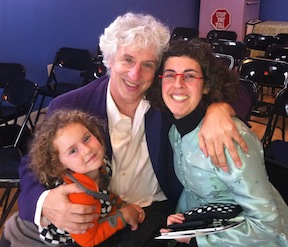
Co-authors (and co-habitators), husband and wife team Sterry and Eckstut, with adorable daughter, Olive.
After everyone had pitched, the judges conferred and came up with a winner. “It was difficult,” they announced (and they meant it), “but one pitch was particularly well-crafted and polished and publisher-ready.” That pitch was given by Robert Macauley, a triple threat in the form of a writer, minister, and physician, whose pitch introduced an epidemiological thriller. Macauley’s two children had accompanied him, sitting attentively through the entire event, applauding for everyone, and quietly but enthusiastically high-fiving and hugging their dad after he gave his pitch. When he was announced the winner, they whooped happily, a wonderful cheering section. Everyone left with a happy glow and some great ideas for taking the next step with their work.
Speaking of kids: we’d been under the impression that children’s books were NOT eligible for the Pitchapalooza, so we’d taken pains to articulate that in our promotional materials. But when one participant (who hadn’t seen that caveat) pitched her picture book to a welcoming panel, and we spoke with the panel afterward, we discovered that all genres had been on the table after all. Whoops! We could easily have a Pitchapalooza event entirely devoted to children’s and YA books, and I think it would be just as packed, if not even more so. I think we’re going to plan one, and soon.
Pitchapalooza was a wonderful, well-attended event, and I recommend it to booksellers everywhere. The participants were extremely appreciative, not only of the panelists, but of our bookstore for making the event happen. It’s just one more example of the kinds of things bricks-and-mortar stores can offer a community that online shopping can’t provide.
A Bliss-ful Event
Josie Leavitt - October 3, 2011
This past Saturday we had the pleasure of hosting Harry Bliss, who spoke about his newest book, Bailey, an utterly charming 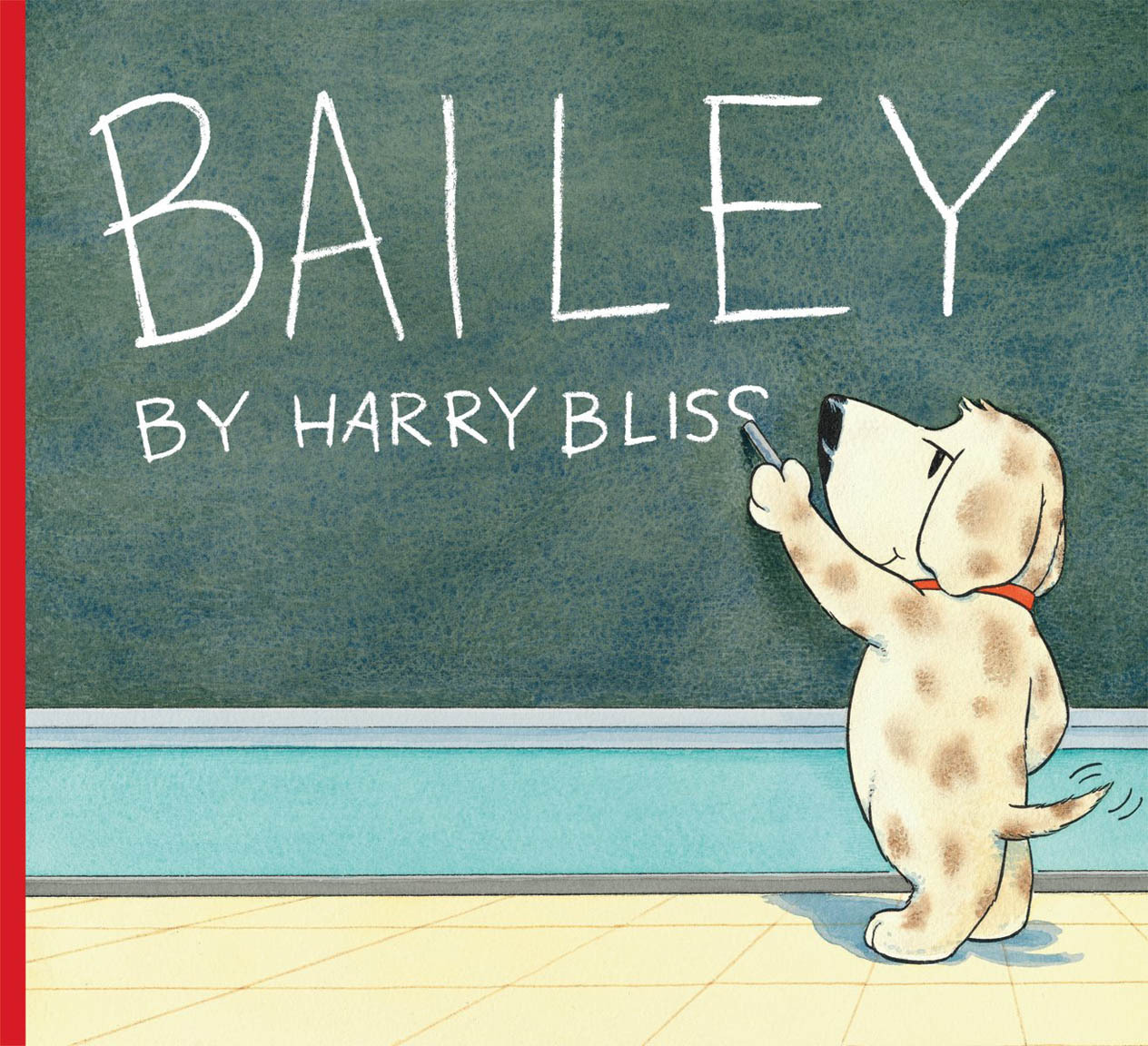 picture book about a dog who goes to school. The beauty of the book is Bailey remains a dog, he doesn’t try to be human to fit in. He steadfastly remains a dog and this is where the hilarity comes in.
picture book about a dog who goes to school. The beauty of the book is Bailey remains a dog, he doesn’t try to be human to fit in. He steadfastly remains a dog and this is where the hilarity comes in.
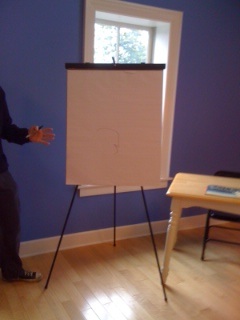 I told Harry this and it bears repeating here: I don’t think there is anyone out there who
I told Harry this and it bears repeating here: I don’t think there is anyone out there who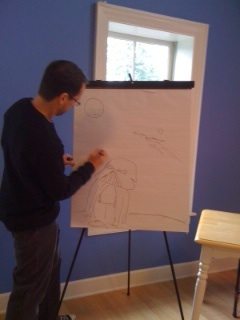 channels a dog better than Harry. For those of us familiar with his New Yorker cartoons, he often captures the thoughts of a dog beautifully, and Bailey is no exception. He goes through the trash in the cafeteria to find lunch, gives bones as gifts and has an ongoing battle with a squirrel. One thing Harry said about Bailey that I found particularly amusing is Bailey’s got his own world, like Snoopy had his own house. He’s got a little dog house and his own cubby. This seemed really important to Harry and it really works for Bailey.
channels a dog better than Harry. For those of us familiar with his New Yorker cartoons, he often captures the thoughts of a dog beautifully, and Bailey is no exception. He goes through the trash in the cafeteria to find lunch, gives bones as gifts and has an ongoing battle with a squirrel. One thing Harry said about Bailey that I found particularly amusing is Bailey’s got his own world, like Snoopy had his own house. He’s got a little dog house and his own cubby. This seemed really important to Harry and it really works for Bailey.
Any event with Harry is magic. He loves to draw for the audience, and this audience was made up primarily of children. One kid has seen Harry all three times he’s been to the store. He participates fully in the “draw a squiggle” part to the presentation. This is where Harry gives a kids a Sharpie and they make a line and from that, Harry makes a cartoon. I am amazed every time that Harry can see a line and turn it into something magical.
Two faint lines turned into a Darth Vader cartoon. Every time I watch Harry draw, I wonder how he can see anythin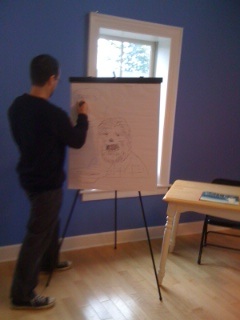 g other than lines. He said he’ll often create a squiggle when he’s working at home to get himself started for a day of drawing. It’s like a warm-up at the gym. I see a squiggle and all I’ll ever see is two or three lines that look like, well, two or three lines. The kids were literally hanging off their chairs, waiting to see what Harry would do with their lines. The smallest child, about 18 months, could barely reach the easel, so her squiggle was quite low. Harry turned it into a mushroom patch with a monster. Pretty cool. The very first squiggle, four simple lines, turned into a werewolf, with a great caption: There’s a hair in my soup.
g other than lines. He said he’ll often create a squiggle when he’s working at home to get himself started for a day of drawing. It’s like a warm-up at the gym. I see a squiggle and all I’ll ever see is two or three lines that look like, well, two or three lines. The kids were literally hanging off their chairs, waiting to see what Harry would do with their lines. The smallest child, about 18 months, could barely reach the easel, so her squiggle was quite low. Harry turned it into a mushroom patch with a monster. Pretty cool. The very first squiggle, four simple lines, turned into a werewolf, with a great caption: There’s a hair in my soup.
The kids were in awe of how quickly he created something out of nothing and the parents really wanted to know how the cartoon process worked. Harry often works from a drawing first and then tries to get the caption. He explained that he’ll do two drawings a day, if he’s not working on a book. I can’t imagine that. I always envy artists. To be able to draw must be such freedom. I see a blank page and wonder when I can start writing on it. It would never occur to me to draw on it to fill it up.
The great thing about an event with Harry is all the kids got to keep their art. They might be too young to realize these are things worth hanging onto, but they sure understood they were magic.
The Kindle Question
Elizabeth Bluemle - September 30, 2011
With Wednesday’s announcement of Amazon’s reply to the iPad, the new Kindle Fire e-reader, my Facebook feed filled up with people’s excitement about the new device. Many of these folks were authors whose books we adore and support and sell in our store, and I realized that even they—people immersed in the industry, whose livelihoods depend on book sales—aren’t aware that almost all other e-readers, including Barnes & Noble’s Nook, DO allow freedom of vendor choice. Many folks just don’t know that they can get an e-reader that isn’t locked to a single supplier. Booksellers, we’ve got to do a better job of getting the word out.
I posted the following update to my personal Facebook page and the Flying Pig’s:
“Before you succumb to the Kindle Fire or other Kindles, please consider that Amazon cuts all other vendors out of the picture, including the indie booksellers who are trying to support your books. Other e-readers allow books to be purchased from a variety of sources, and with agency pricing across so many publishers, the cost is often the same.”
I was glad I did, because there were some questions right away:
- Wait, indie bookstores sell ebooks? (Answer: Yes. Many, if not most, of us do.)
- How do we buy them? (Some websites offer ebook options along with other formats; others have affiliate programs with Google eBooks, and if you link to Google eBooks through the indie store’s website, they’ll get that percentage of the sale.)
- Can I buy books from an indie and read them on my Nook? (Answer: Yes. You can buy ebooks from other sources than B&N and read them on your Nook. You can also read them on many, many other e-reader devices. I believe only Amazon boxes out all other formats but its own.)
We indies need to do a better job getting the word out about the fact that we DO sell ebooks, and let our friends, family, and customers know how to buy them from us. It is a matter of survival for all bricks-and-mortar stores. Recently, I made a flyer and posted it at the store:

Even if I weren’t an independent bookseller, it would alarm me to be beholden to a single vendor for my book purchases. It just places too much power in the hands of a single corporate entity, one that could conceivably “recall” books from my device, or decide not to carry certain authors or titles. The world of technology is zipping along, and gadget frenzy is a seductive thing. Once in a while, all of us need to take a breath and think, “What am I really buying here?”
Should the Bear Eat the Rabbit?
Josie Leavitt - September 29, 2011
It’s been out for just a few days and already there has been a lot of discussion at my store about 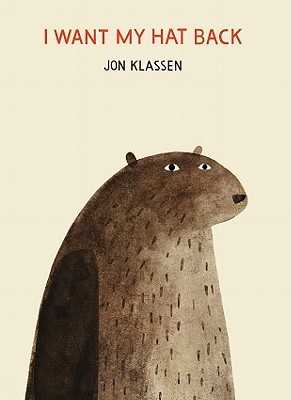 Jon Klassen’s book, I Want My Hat Back. I need to go on record as saying I LOVE this book.
Jon Klassen’s book, I Want My Hat Back. I need to go on record as saying I LOVE this book.
The plot is simple: a bear has lost his hat and asks a series of animals if they’ve seen it. Rabbit, who is actually wearing the hat, says that he hasn’t seen the hat. In the end, the bear realizes the rabbit has his hat. In one spread the rabbit is there, and in the next, there is evidence of a scuffle, but no rabbit. But bear is wearing is hat.
There have been customers who love the book until these last few pages when the Bear seemingly eats the rabbit. Personally, I think it’s funny. One has to take it on faith that the author is not advocating death for taking a hat in the real world. But I think too many people expect all picture books to be necessarily cheery and full of the ubiquitous tidy endings where all is forgiven and the animals hold paws and play checkers.
What this book does is bring to light the feelings a child might have about someone stealing, and then lying about stealing, a treasured hat. It is not an advice manual. Kids have real emotions, and sometimes they’re dark and scary. But this book is tongue in cheek. And the way the Bear dispenses with the Rabbit is dealt with in exactly the same way the Rabbit lies about taking the hat. The cleverness of this book lies in its pure simplicity and dialog.
Admittedly, it’s not every day that the protagonist of a children’s book actually kills another character with no repercussions, at all. There are books where the protagonist does bad things and then learns from his or her actions, but in this book the rabbit is gone and bear gets his hat back and is happy. I think this book can inspire some pretty amazing discussions in classrooms and homes of kids of varying ages about lying, consequences and what’s right and wrong and also you could have a real debate as to whether or not the bear actually ate the rabbit. Also, it’s never too early to teach kids about black humor.
Face Out or Spine Out: One Customer’s Opinion
Josie Leavitt - September 27, 2011
I was working alone in the store on Sunday, having a really great day, when a customer came in and challenged me on how to shelve books. After I had rung up his $89 of books — Dick Cheney and the new Jackie Kennedy (if only everyone could be so bipartisan) — and he was leaving, he called me over to the front door.
“You want to sell more books?” He asked. “Of course.” I said.
“Well, you ought to face them all out. Then they’d be easier to see.” He suggested this like it would be a revelation to me. He even did a little demonstration of how he found one book, but had to ask for help for the other, even though it was eye level, but spine out. I explained that the face out, while lovely and ultimately, ideal, is not practical for space reasons.
“You just need new shelving.” He kept saying over and over. I told him, nicely, that it wasn’t the bookcase that was causing the problem — it was just a space issue. If I faced out all my books two things would happen: I’d need to be in a store three times as large, or my stock would be cut in half and then people would say I had no depth to my inventory. I even showed him how many more books can fit on shelf spine out (20) versus the seven faceouts on a nearby shelf. If I have 30,000 books now and I faced them all out, without culling the stock I would need to have a 4,000 square foot store, or get rid of two thirds of my inventory. Either way, it just wouldn’t work.
Still, he persisted. “They even have this problem at Barnes and Noble.” I know! It’s a space issue, not a bookcase one. He said he hated looking for books all in a row on the shelf. I told him that’s why employees are there, to help folks find books, just like I had with the new Jackie Kennedy book.
So, how do other stores deal with the face out/spine out issue?
A Wonderful Week of Author Events
Josie Leavitt - September 26, 2011
This past week saw four great authors come to the Flying Pig. Our 15th anniversary celebration was in full swing. We kicked off with none other than Lois Lowry on Wednesday.
I had the pleasure of introducing Lois and I found myself almost at a loss for words and kind of choked up, which doesn’t happen to me often. Lois is one of my favorite writers, so it’s easy to get star-struck. The event was jam-packed and Lois was a delight. Our co-worker, JP, made a note for us to share in this blog. It was Lois’s advice for writers of all ages. “Write about what you wonder about.”
Lois was touring for her newest book, Bless This Mouse. The book is charming and Lois read the last few pages with great vigor, humor and a twinkle in her eye. Kids were laughing and parents loved it. I also enjoyed her telling the crowd that Jonas, from The Giver, is very much alive. She even has a shirt that says: Jonas Lives. I want this shirt.
Friday had me escorting Brandon Mull and Matt Myklusch to two schools for three separate presentations and then a store event. These two were troopers and lots of fun to hang out with. I always worry when I escort authors. I want them to be happy, be fed when they’re hungry, have the right beverages, and have enough down time. Sometimes it can be a challenge, but Friday was a breeze.
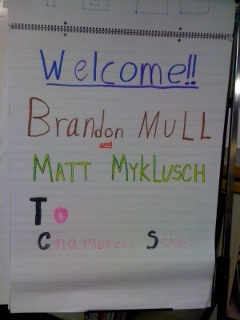 Brandon and Matt were new to each other, so we all were getting to know each other. One thing that I found endlessly entertaining was each author took turns riding shotgun. Matt called it first and then every time we got in the car, they would switch. This just killed me.
Brandon and Matt were new to each other, so we all were getting to know each other. One thing that I found endlessly entertaining was each author took turns riding shotgun. Matt called it first and then every time we got in the car, they would switch. This just killed me.Brandon was touring in support of Beyonders: A World Without Hero and Fablehaven and Matt was speaking about his first two books, The Jack Blank Adventures, Accidental Heroes and The Secret War.
The kids loved their presentations. Each man spoke about not giving up on dreams. And both really stressed the importance of imagination. The 150 seventh and eighth graders really took this in as they sat intently listening. To have that many middle school students silent meant the message was clearly getting through.
 Our last event of the week was Erica Perl on Saturday. Her newest book is When Life Gives You O.J. a charming book about a sixth grader, who has a “practice pet” made out of an orange juice container. The fun of this event was Erica herself. She’s an enthusiastic presenter who brings a lot of swag to give away. We had a practice pet parade (the local coffee shop saved several days of milk containers for us) and all the kids got prizes. Among the contestants were Lily, with her dog Purple Nose, whose skill was playing dead, so they won the prize for most dramatic.
Our last event of the week was Erica Perl on Saturday. Her newest book is When Life Gives You O.J. a charming book about a sixth grader, who has a “practice pet” made out of an orange juice container. The fun of this event was Erica herself. She’s an enthusiastic presenter who brings a lot of swag to give away. We had a practice pet parade (the local coffee shop saved several days of milk containers for us) and all the kids got prizes. Among the contestants were Lily, with her dog Purple Nose, whose skill was playing dead, so they won the prize for most dramatic.  A young boy didn’t make a practice dog, but rather a rhino named LeRoy who won an award for best
A young boy didn’t make a practice dog, but rather a rhino named LeRoy who won an award for best 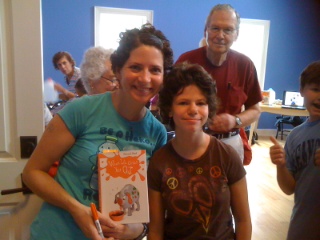 horns.
horns.Perhaps the nicest moment of the whole event was Erica’s with a girl named Eva. This was Eva’s first-ever book signing and she took it very seriously. After I took her picture I asked if I could use it in my Publishers Weekly blog. She exclaimed, “Oh, my, Publishers Weekly!” And then she turned to her grandmother and whispered, “What’s Publishers Weekly?” A great week of events ended with a laugh.

